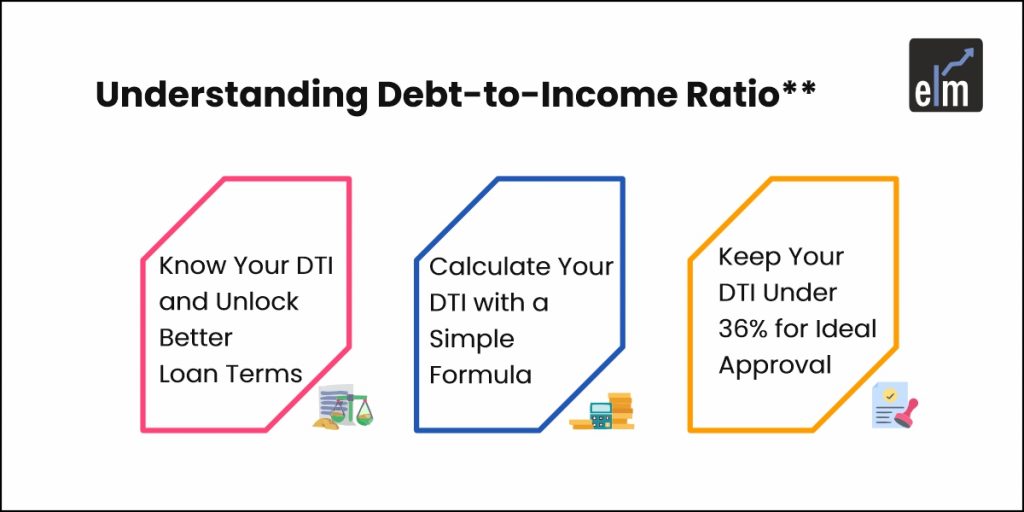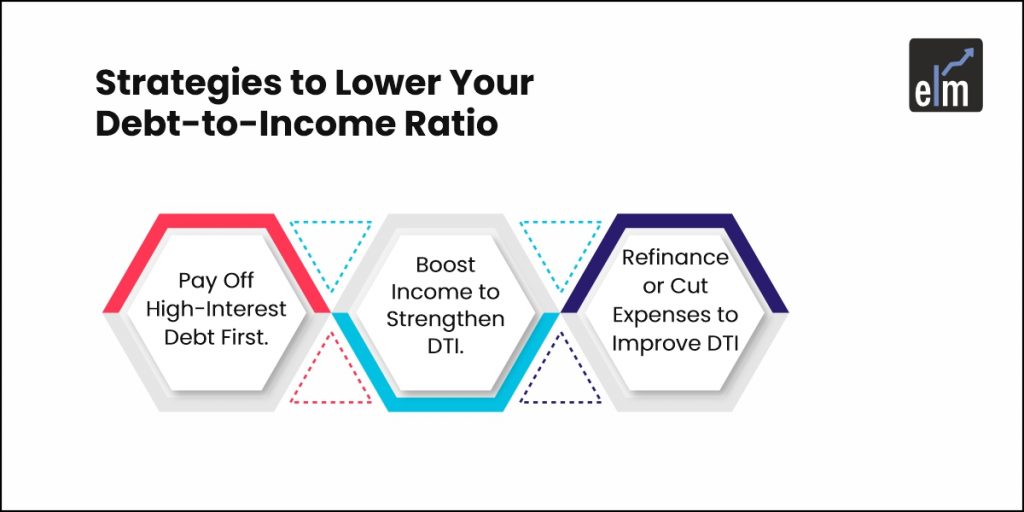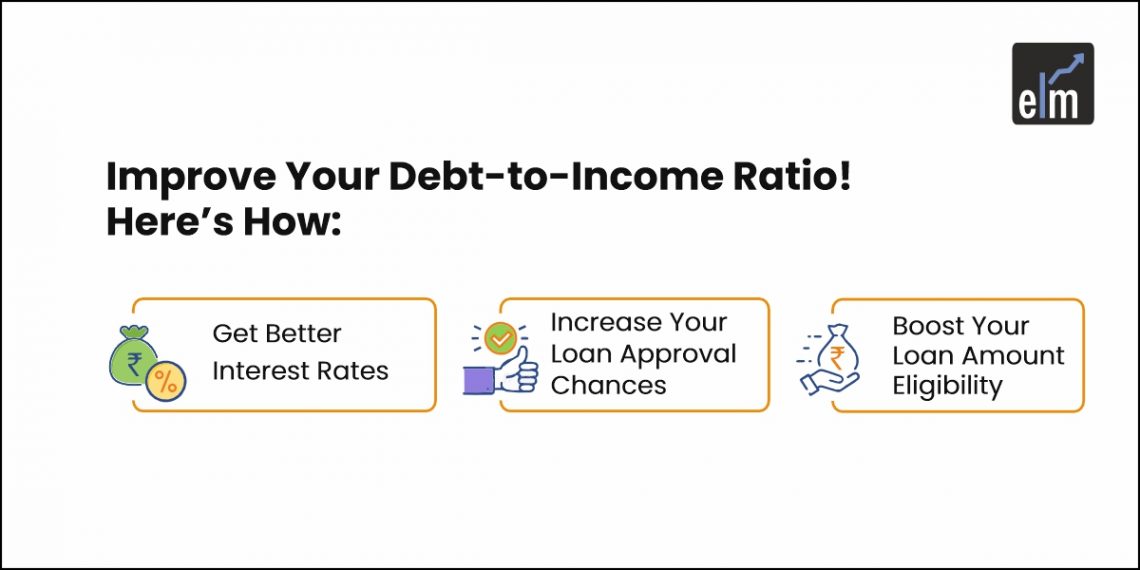Introduction
Every business owner dreams of expanding their business and capturing new markets, however, the cost involved in expansion is a common roadblock for ambitious businesses. To overcome the financial challenges in expanding, businesses usually reach out to banks or lending institutions for capital.
When approaching a lender for a business loan, it is important to be also aware of the debt-to-income ratio (Debt-to-Income Ratio), which plays an important role in the approval of the loan and the interest rate applicable to your potential business loan.
Let us understand;
- What does the Debt-to-Income Ratio actually mean? and
- How you could Reduce Debt to Income Ratio.
What is the Debt-to-Income Ratio?
According to lenders, The Debt to Income Ratio is the percent of income that is paid towards debts. It is simply the percentage of how your total monthly debt payments are compared to your total monthly income.
From the illustration above, if your total monthly income is about ₹1,00,000 and your total monthly debt payments are ₹40,000, then your (Debt-to-Income) Debt to Income Ratio would be 40%.
To calculate the Debt-to-Income Ratio, use the below formula;
DTI=(Total monthly income / Total monthly debt payments)×100
Let’s break it down:
Total debt obligations per month: This is the sum of all debts; it includes small business loan, personal loans, credit card payments, and other monthly debt obligations.
Total monthly income: This is the amount of total income generated monthly from your business, salary, or any other source of income.
For example, let us assume you pay ₹30,000 in installments of the business loan, along with ₹10,000 in personal loans, and the average monthly income you receive is ₹1,00,000. Your DTI ratio is;
DTI=(1,00,000 / 40,000) × 100 = 40%
A low DTI ratio makes lenders happy because it leaves them feeling confident that they will have enough take-home income remaining to pay all their other debt obligations without being overwhelmed. The good DTI is usually 36% or lower; higher, and it might become harder to get cheaper business loans or even to get a loan.

DTI Ratio Impact on Business Loan Costs
It directly affects the cost of a business loan. Lenders will measure your ability to manage the other debt by your DTI ratio. Here’s how it affects your loan costs:
Interest Rates: This ratio must be as low as possible. That way, the more disposable the person can pay back the loan, and they’ll be less risky to the lender. Thus, interest rates will be lower. If the ratio is relatively high, then perhaps you’re already stretched pretty thin on your side, and interest rates will go up to make up for the risk of lending.
Loan Approval: Your loan application will be rejected owing to the high DTI ratio making the lender feel you already owe too much. That is their way of seeing it-they think you are already involving yourself in much debt obligation and, therefore, would not be able to pay back to them.
Loan Amount: You qualify for a loan, but you have a high DTI ratio which may lower your amount of borrowing. The lender will reduce the amount he is willing to lend to you because he may be afraid that you will not comfortably repay a greater loan.
Fees and Charges: Some lenders may charge processing fees or insurance if your DTI is high. These make the cost of your loan higher.
How to Lower Your Debt-to-Income Ratio
This can help enhance your chances of getting the required msme business loan in a better way. Here are some recommendations that can help you lower your DTI:
Remove outstanding debts: The easiest way to lower the DTI ratio is by paying off outstanding debts. Start by paying off debts and loans that carry a high interest rate and small outstanding balances. Automatically, the money owed in debt will be decreased as well as the monthly payments on debt and the DTI ratio.
Earn More Money: You can easily lower your DTI by earning more money. Again, there are various ways you may try to do this, such as opening up new sources of revenue for your business, taking on more projects, or selling more items. This will lower your DTI ratio since your debt will compose a smaller percentage of your total income.
No New Loans: Avoid new loans and lines of credit in the short period leading up to submitting the loan application. These weigh heavily against your debt and shoot your DTI ratio up, which is not a favorable position to be in when that loan is being applied or at better terms.
Refinance Existing Loans: If you have existing loans with high interest rates or large monthly payments, then consider refinancing them by balance transferring them with banks or any financial institution. You can refinance to obtain a low rate of interest on the loan or increase the term for a longer period for the repayment of the loan, which would reduce the monthly payments like EMIs which improves your DTI ratio.
You can Consolidate your Debt: Consolidation debt combines several loans-one might have several and owing money on more than one credit card, personal loan, or another type of loan-into one loan or a single payment program. Essentially, the idea behind consolidating debt is that the process will help you avoid struggling with so many debts, and hopefully lower the interest rate, making that much less of a headache about paying off your financial obligations. so that it will be effortless to reduce your DTI ratio.
Stop Non-Essential Expenditures: Go through all of your business and personal expenses and remove all the non-essential expenses. The more you save through the elimination of expenditures, the more money you can save money to pay back some of those debt loans; this action decreases your DTI ratio.

Conclusion
Managing your debt-to-income ratio can make your chances of getting a business loan at favorable terms much better. A low debt-to-income ratio is a mark of lenders that you are in more control of your debts and less risky to lend to. Considerable differences in your debt-to-income ratio could be made by reducing the outstanding debts in your books, increasing your income, refraining from new loans, and refinancing or consolidating the existing loans. Thus, these steps improve one’s financial well-being but, simultaneously, increase business prospects with easy credit.
NBFCs primarily concentrate on offering substantial amounts of loans to businesses, especially MSMEs. Such NBFCs offer flexible lending services and are usually more accessible to MSMEs that may not qualify under traditional bank loans due to higher DTI ratios or the absence of proper collateral. These help fill in the gap within the credit cycle as they support expansion in businesses, meet working capital requirements, and even provide funds for equipment purchases.






